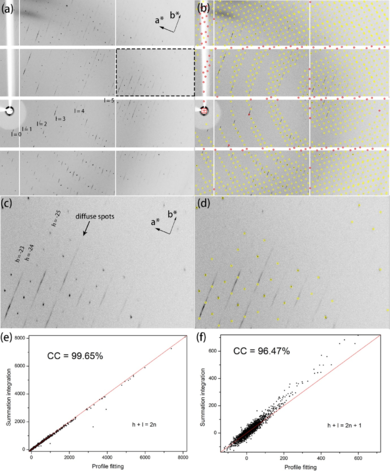Journal:Acta Cryst D:S2059798320011869
From Proteopedia

Lattice-translocation defects in some specific crystals of the catalytic head domain of influenza neuraminidaseLinghui Li, Shuliu Dai, George F. Gao and Jiawei Wang [1] Molecular Tour  Figure 1 The first image of diffraction data of a toad NA crystal. (a) Raw image with the reciprocal-space index l shown, as well as the a* and b* axes. (b) The same image with all predictions shown. (c) The enlarged section of the frame in (a) with the h index shown. The smeared diffuse spots are indicated with an arrow. (d) The enlarged section with predictions larger than 5 σ shown. (e) The correlation of spot intensities integrated with profile fitting and summation methods with the indexes (h+l) of even, (f) (h+l) odd.
In the lattice-translocation defect crystals, every other layer is either in the Fig. 5b orientation or in the , and the choice is absolutely random. This randomness breaks the long-term periodic and forms a local short-term periodic. This appears to be the particle-size broadening (Coppens, 1997)[2]. If the long-term periodic is broken, the diffraction intensity would spread along the reciprocal-space direction of the step function. In this special case, it is the b* direction. With the spread of the reflections, the subsidiary maxima of the neighboring reflections may overlap, which will result in the smear spots, the especial chacteracters of LTD. In the intensity deconvolution methods, the randomly distributed two different kinds of layers (third in Fig. 6a) were supposed to accumulate into two mosaic domains (fourth in Fig. 6a), which is similar to twining (Dauter & Jaskolski, 2016)[3]. The corrected intensities could be obtained by dividing the observed value by the factor of [(2k2-2k+1)+2k(1-k)cos(2πhtd)]. Therefore, LTD problem could be solved. References
| |||||||||||
